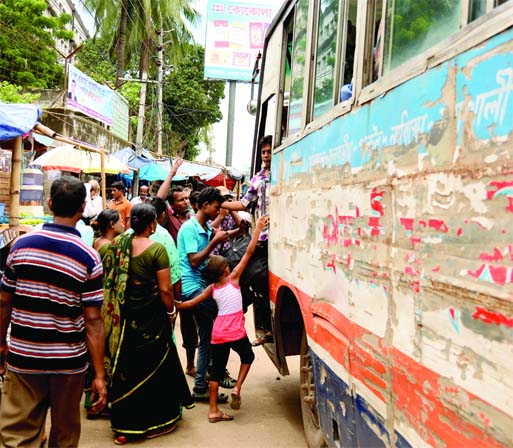
SM Mizanur Rahman :
As a serious indiscipline continues on the city roads, there is no immediate way out to get rid of gridlock, rather the situation is deteriorating gradually, say experts.
“Discipline has totally broken down on the city roads. It is not possible to restore discipline on the roads if irrational granting of route permits of vehicles is not stopped,” an urban expert said.
A journey from Abdullahpur to Motijheel or Gulistan-Motijheel to Mirpur is a painful experience to all passengers and drivers everyday. Besides, commuters in other routes also experiencing similar suffering each day.
According to experts and traffic police, this totally mess transport makes the city’s important gateways overcrowded and its gridlock impact spills over the entire thoroughfares of the metropolis. Traffic movement also comes to a halt on around 30-kilometre long north-south corridor, namely Gazipur-Mohakhali, where a huge number of buses of 60 routes run from Tongi, Abdullahpur, Uttara, Kuril and Khilkhet direction at a time everyday.
One of the worst traffic congestions is experienced on the Airport and Jashimuddin roads in Uttara as Hazrat Shahjalal International Airport, Airport Railway Station, and Headquarters of Civil Aviation Authority, Bangladesh Armed Police Battalion and the elite force Rapid Action Battalion are situated on the both sides of the roads.
While visiting the spot yesterday, this reporter found that the area lacked adequate sidewalks, zebra crossings, parking facilities, bus terminals, passenger sheds and other traffic mismanagement.
Many vehicles were seen parking haphazardly on the street while buses stop far from the stoppage for taking passengers and thereby creating chaos on the city roads everyday.
Drivers of the buses show less regard to traffic rules, making the matters further worse, it was observed.
“The traffic jam is more severe everyday here in the airport area compared to other parts of the city as many outgoing and incoming passengers from home and abroad land at the airport,” said an on duty traffic police.
Talking to The New Nation, Professor Shamsul Hoque, an expert on transportation and safety on Tuesday said that neither any traffic police nor the city corporation mayor would be able to free the city from such gridlock if the authorities concerned continue to allow new buses on the routes overlooking the experts’ recommendations and suggestions.
According to a data available with Bangladesh Road Transport Authority (BRTA), around 6,000 buses and minibuses run on a total of 209 routes in the capital city.
“We suggested on several occasions to bring down the number of city bus routes to get rid of gridlock. But our suggestions were overlooked,” said Professor Hoque.
He said when people with their vehicles enter the cantonment area they can reach their destinations smoothly as they are compelled to follow the traffic rules and regulations.
Apart from traffic police, the expert said, if the government deploys additional forces to compel the drivers to follow the rules and prevent the plying of unfit and unlicensed vehicles the present situation might be improved.
“The regulatory body has failed to ensure smooth traveling of the pedestrians. It also failed to abide by the automobile and non-automobile vehicles to ply on separate routes. The pedestrians should use the pavement while the non-motorised vehicles like rickshaws ply on the road which is allowed for them,” Professor Hoque said.
He said in the absence of a separate lane for rickshaws on most of the roads, they occupy the whole road space and hamper the movement of motorised vehicles, which can, at best, move at 15 to 20 km per hour.
Talking to this reporter, Professor AAM Amanat Ulllah Khan, an urban expert said many research and surveys have been conducted to find a way out in order to ease the traffic system but all efforts went in vain due to pressure of huge number of vehicles on the roads.
“We have no recommendations and suggestions right now. But if the Prime Minister herself deals the issue strictly, I think discipline will return on the city roads,” he said.
He said road discipline is the first sign of civilised urban societies, while breaking of road rules and chaotic traffic jams indicate towards ignorant and careless citizens, as well as, inefficient and corrupt traffic authorities.
“The arrival of fresh number of vehicles that hit the road every year and the huge increase in the number of rickshaws, many of which are unlicensed, are intensifying the traffic congestion,” he said. The expert said that the minimum road requirement is 25 per cent for a standard city, whereas Dhaka city has only 7.5 per cent road of its total area.
Talking to journalists on Tuesday Home Minister Asaduzzaman Khan Kamal said police in association with a China company is conducting a survey in the capital to detect the root cause of traffic congestion.
“Based on the survey report, effective initiatives will be taken to redress the problem,” he added.

